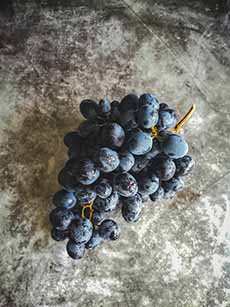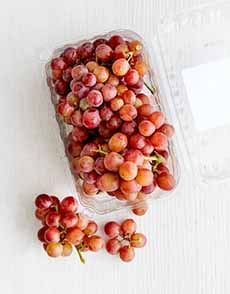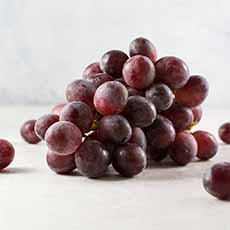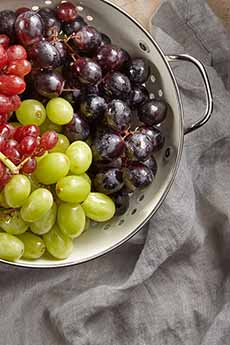TIP OF THE DAY: Freeze Grapes For A Sweet Snack
|
|
A trick long known by clever dieters is to freeze grapes. Then, when you’re aching for something sweet, just pop a few grapes into your mouth. Freezing intensifies the sweetness of the grapes. Makers of the sweet dessert wine, ice wine*, rely on frozen grapes. The result is like a grape slush (Slushie is a brand name) or sorbet. It’s as tasty for adults as for kids. Grapes are good nutrition, too: high in antioxidants, manganese, potassium and vitamins B-1 (thiamine) and C. They’re low-fat and low-calorie, too: an excellent snack food. First, use seedless grapes. For eye appeal, consider using a mixture of colors. 1. WASH the grapes and let them air-dry thoroughly. Then, take them off the stems and lay them on a baking sheet or tray atop parchment, plastic wrap, or wax paper. 2. PLACE the tray in the freezer. Grapes are around 80% water, so they’ll freeze quickly. 3. REMOVE the frozen grapes from the tray and place them into a freezer-friendly bag or container. They’re ready and waiting in the freezer for your next snack attack. Grapes are an ancient crop. The ancestor of European grapes, Vitis vinifera, grew wild in the Near East, as early as the Neolithic era. Viticulture, the cultivation of grapes, may have begun as early as 6500 B.C.E. Wild yeast occurs naturally on the skins of grapes, leading to an automatic fermentation that produced wine. The earliest archeological evidence for wine-making has been found some 8,000 years ago in Georgia, in the Caucasus region of Eurasia [source]. Not surprisingly, the cultivation of grapes for wine-making became a focus for many farmers. As early as 3000 B.C.E., the Hittites spread viticulture westward, to Crete, the Bosporus and Thrace (now modern Turkey). By 4000 B.C.E., viticulture extended from Transcaucasia to Asia Minor, and through the Nile Delta of Egypt. Later, the Greeks and Phoenicians extended grape-growing to Carthage, Sicily, southern Italy, Spain and France. Under the influence of the Romans, grape production spread throughout Europe. King Hammurabi of Babylon (1792 – ca. 1750 B.C.E.) may have enacted the world’s first liquor law when he established rules for the wine trade in 1700 B.C.E. [source]. By the time of the fall of the Roman Empire, 395 C.E., grape culture and wine-making had become the province of monasteries. Wine was used in religious rites. By the Renaissance, the use of wine extended beyond religion to popular social custom. This increased demand for grapes, and grape culture grew steadily from the 16th to the 20th century. In North America, native grapes grew wild across the continent. They were a part of the diet of many Native Americans, but were not considered particularly enjoyable by early colonists. It wasn’t until the 1850s, when American grapes began to be hybridized with European varieties, that table grapes became more widely grown and consumed [source]. |
|
|
Early European colonists also found the native grape varieties to be unsuitable for wine. (Two varieties ultimately were successful: the Catawba grape and the Concord grape, both varieties of Vitis labrusca.) In 1629, Spanish Missionaries discovered the dry climate and sandy soils of New Mexico. They planted the first Vitis vinifera (European grape variety) vineyards on the continent in their missions. The grape variety, brought from Spain, became known as the Mission grape. Other grape seeds and cuttings were brought from Europe and planted in America. In California, the first vineyard and winery was established by Spanish Catholic missionaries in 1769 [source]. If you wonder why the historic record focuses on wine-making and not on table grapes for eating, the answer is simple. As with beer, wine was safer to drink than water, the sources of which were often contaminated. Equally, the mood-enhancing qualities of alcoholic beverages were welcome. *Ice wine (Eiswein in German) is a type of dessert wine produced from grapes that have frozen while still on the vine. The sugars and other dissolved solids do not freeze, but the water does. This creates a more concentrated grape juice. The frozen grapes are then pressed, resulting in a more concentrated, very sweet wine. |
||



